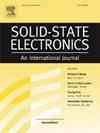Emission cells with quantum dots on silicon chip prepared by using fs pulsed laser
IF 1.4
4区 物理与天体物理
Q3 ENGINEERING, ELECTRICAL & ELECTRONIC
引用次数: 0
Abstract
Emission efficiency of bulk-silicon is very low due to its indirect-gap of energy band. However, it is interesting that the enhanced emission has been observed in the micro-cavities array fabricated by using femtosecond (fs) pulsed laser, in which the stimulated emission characteristics occur after annealing for suitable time in the photo-luminescence (PL) measurement at room temperature. The results of experiment and calculation demonstrated that the enhanced emission may be originated from the Si quantum dots embedded in the micro-cavities prepared by fs pulsed laser. Here, the direct-gap of energy band appears after annealing due to the Heisenberg principle related to ⊿k–1/⊿x in quantum system of nanostructures. The PL intensity obviously increases on the Si quantum dots growing with annealing for better crystallization, in which the external quantum efficiency is higher than 40 % near 760 nm. A new kind of emission source of the micro-cavities array in visible wavelength has been built on silicon wafer, in which the Si quantum dots play a main role for enhancement of emission. It should have a good application in optical integrated chip based on silicon, such as emission cells built on Si chip.
利用 fs 脉冲激光在硅芯片上制备量子点发射电池
由于能带的间接间隙,硅块的发射效率非常低。然而,有趣的是,在使用飞秒(fs)脉冲激光制造的微腔阵列中观察到了增强的发射,在室温下进行光致发光(PL)测量时,退火适当时间后会出现受激发射特性。实验和计算的结果表明,增强的发射可能源于fs脉冲激光制备的微腔中嵌入的硅量子点。在这里,由于纳米结构量子体系中与⊿k-1/⊿x相关的海森堡原理,能带的直接隙在退火后出现。在退火后生长的硅量子点上,PL 强度明显增加,结晶效果更好,其中 760 纳米附近的外部量子效率高于 40%。在硅晶片上构建了一种新型可见光波长微腔阵列发射源,其中硅量子点在增强发射方面发挥了主要作用。它可以很好地应用于基于硅的光学集成芯片,如在硅芯片上构建的发射电池。
本文章由计算机程序翻译,如有差异,请以英文原文为准。
求助全文
约1分钟内获得全文
求助全文
来源期刊

Solid-state Electronics
物理-工程:电子与电气
CiteScore
3.00
自引率
5.90%
发文量
212
审稿时长
3 months
期刊介绍:
It is the aim of this journal to bring together in one publication outstanding papers reporting new and original work in the following areas: (1) applications of solid-state physics and technology to electronics and optoelectronics, including theory and device design; (2) optical, electrical, morphological characterization techniques and parameter extraction of devices; (3) fabrication of semiconductor devices, and also device-related materials growth, measurement and evaluation; (4) the physics and modeling of submicron and nanoscale microelectronic and optoelectronic devices, including processing, measurement, and performance evaluation; (5) applications of numerical methods to the modeling and simulation of solid-state devices and processes; and (6) nanoscale electronic and optoelectronic devices, photovoltaics, sensors, and MEMS based on semiconductor and alternative electronic materials; (7) synthesis and electrooptical properties of materials for novel devices.
 求助内容:
求助内容: 应助结果提醒方式:
应助结果提醒方式:


